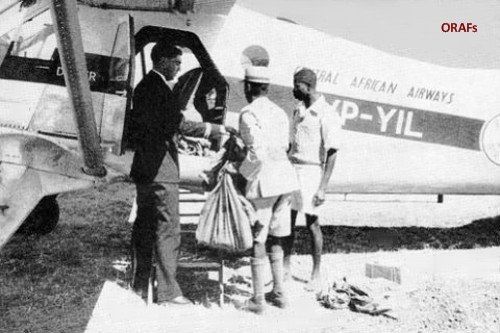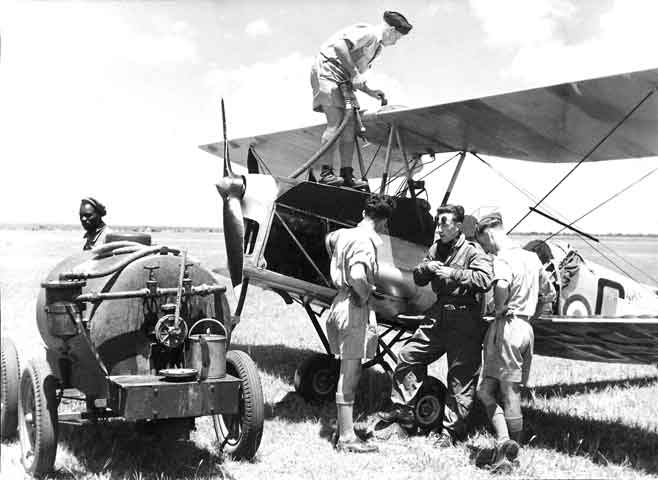Early Aviation
The Age of Air
The route between London and Cape Town was regarded as one of the challenges for aviators. In 1918 the British Air Ministry dispatched survey teams to Africa to pave the way for an air route from Cairo to Cape Town. Three survey and construction teams established landing grounds along the route. After a year of bundu-bashing and levelling anthills, the Ministry declared the "Cape to Cairo" air route open in December 1919, providing 24 aerodrome and 19 emergency landing strips fit for use.
The Times of London announced that it would finance the first flight to the Cape and its aircraft - a Vickers Vimy Commercial, G-EAAV, took to the air on 24 January 1920, piloted by Captains S Cockerell and F C Broome, with Dr Chalmers Mitchell, Secretary of the Zoological Society.
General J.C. Smuts however wanted South African aviators to be the first to complete the trip. He therefore authorised the purchase of a Vickers Vimy, G-UABA, at a cost of 4 500 pounds. Christened the Silver Queen, and commanded by Lt Col H.A. (Pierre) van Ryneveld with Lt Quinton Brand as co-pilot, the aircraft took off from Brooklands (Surrey, England) on 4th February 1920, aiming to overtake the Times sponsored plane. After an eventful night crossing of the Mediterranean, they arrived at Derna the following morning. Further night flying followed in an attempt to catch the Vickers Vimy, but the Silver Queen was wrecked in a forced landing at Korosko, near Wadi Halfa in the Sudan. A leaking radiator forced a night-time emergency landing, and in the dark the plane ran into rocks. The crew survived serious injury. A second Vimy F8615 was loaned from the Royal Air Force at Heliopolis, in Egypt, and on February 22nd the two pilots returned to the skies.
https://www.tothevictoriafalls.com/vfpages/tourism/air.html
By 1920 the "Cape to Cairo" dream of a railway running the length of Africa was about to be eclipsed by aviation. About the same time as Sir Alan Cobham was surveying a route for Imperial Airways to use from Cairo to Cape Town, a little-known flight by four Fairey 3111 D's based at RAF Northolt took place. Between March and May 1926 they flew a return trip from Egypt to South Africa. Shown in this unique photo are the four planes parked at Ndola Airfield. Among the pilots is Wing Commander C. Pullford explaining that the purpose of the flights was to gain experience in long-haul formation flying!
Northern Rhodesia Aviation Services
[ZAMBIAN AIRWAYS was formed as Northern Rhodesia Aviation Services in 1948 and renamed to MINES AIR SERVICE in 1965. It was then renamed to ROAN AIR upon privatisation in 1998 and then to it’s current name in 1999. Became a BA franchise in early 2001. Domestic services but suspended operations on 10Jan2009]
https://airlinehistory.co.uk/airline/northern-rhodesia-aviation-services/
Beaver Safari in Northern Rhodesia (1961)
http://rhodesianheritage.blogspot.com/2013/06/beaver-safari-in-northern-rhodesia-1961.html
Flight Lieutenant Brian B "Bebe" Sharman
One of the Founders of the Jever Steam Laundry and a pilot on 98 Squadron
A photographic Record of his time with the RAF - Album 3 Feb51 to Nov51.
http://www.rafjever.org/98sqnper005-3.htm
Wings over Africa
By John Hamlin
The Rhodesian and Central African Annual – 1954
Gliding is an old a pastime as any, but it is only comparatively recently that man has indulged in it. It is fascinating, and in Rhodesia, as elsewhere, clubs have sprung up which enable the enthusiasts to fly without the aid of expensive motor-driven aircraft, and to do so at reasonable cost.
In Southern Rhodesia there are several clubs throughout the country from Umtali to Bulawayo. On small landing strips each week-end those keen on gliding gather to launch the frail looking craft, with their one or two occupants, high into the African skies, to glide and turn and twist, using, as the birds have done for countless years, the knowledge of the winds, the up and down currents, thermals and other means known to gliding enthusiasts to keep aloft.
Zambia Airways
Zambia Airways was the national airline of Zambia until its collapse in 1994. During its establishment in 1964, the airline was part of the greater Central African Airways and operated three DHC-2 Beaver and two Douglas DC-3 aircraft. The airline operated flights to Kenya, Malawi, Tanzania, and Mauritius. After it became an independent airline in 1967, it acquired two BAC 1-11-207s and several HS.748s aircraft. Zambia Airways also leased a DC-8 from Alitalia which operated on the Lusaka - London route twice a week via Nairobi and Rome. In 1975 the DC-8 and the BAC 1-11s were replaced by Boeing 707 and Boeing 737 respectively. Freight soars 52.8% while the number of passengers increased by 22.39%. In 1971, Simon C. Katilungu took over as the chairman of the airline and immediately began talks with the Botswana, and in 1972 the airlines began direct flights between Lusaka and Gaborone.
In early 1976 two Irish Stratoliners were delivered, and in June 1976 a B-737-2M9A arrived and began operating flights from Lusaka to Frankfurt. In August of the same year, the airline faced its first pilot strike that left the airplanes grounded for four months. On May 14, 1977, the airline experienced its first airplane crash when a Boeing crash-landed in Lusaka. In 1984, Zambia Airways received its first wide-body aircraft, a DC-10-30, which was a move that led the British government to limit the airline flights to London. On April 1, 1988, the DC-10-30 began flights to New York via Monrovia. In April 1989, Zambia airlines signed a pact with Pakistan International Airlines Corporation (PIA) in which the Asian carrier would provide computerization, engineering, accounting, and technical assistance. In May of the same year, the airline leased a DC-8-61 from Nationair, Ltd to double the flights to New York through Monrovia. In 1990 the airline acquired an MD-11, and in December it became the only airline outside of the US to order a B-757-23APF after leasing one from Ansett Worldwide Aviation.
The Fall of the Airline
By 1991 the airline employed about 2,130 people. However, the crisis in the Middle East at the time led to an increase in operational costs, particularly related to the cost of fuel. The airline was forced to terminate flights to New York, the number of passengers fell 37.2%. Furthermore, the order placed on the MD-11 was canceled due to a weak financial position. In 1993 the airline reduced its employees to about 1,900 and disposed a B-757-23APF. The government set off a restructuring program to save the airline from bankruptcy including the sale of several assets.
In 1994 the government hired more employees and set off a plan to privatize the airline. The airline showed signs of recovering but still owed about $100 million in debt. On December 3, 1994, the airline ceased operations, all employees were dismissed, and the company was liquidated. The airline’s DC-10-30 planes were sold to Monarch Air Lines, Ltd. in 1995. On July 2, 2017, the Minister of Transport and Communications stated that the government had plans to re-establish the airline although no official statement has been issued by the government.
https://www.worldatlas.com/articles/what-is-the-national-airline-of-zambia.html
https://www.lusakatimes.com/2018/08/14/the-28-year-adventure-the-zambia-airways-story/ By Brian Mulenga








